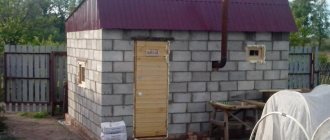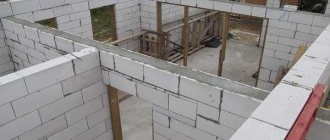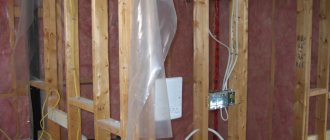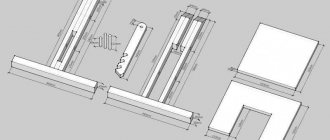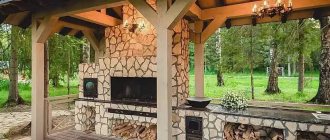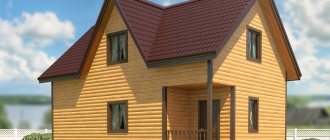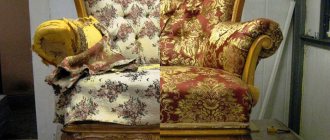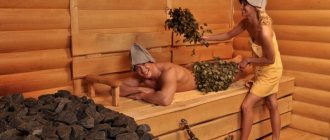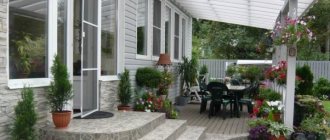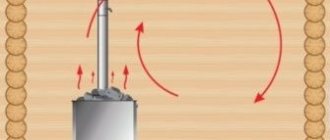Bathhouse projects with terrace and barbecue
Meeting friends, conversation and relaxation are closely associated with barbecue. Where there is a barbecue, there is a grill. And the only thing better than a portable barbecue is a stationary barbecue. So they often plan bathhouses with a terrace and barbecue.
Large terrace and outdoor barbecue area
In this bathhouse project, the terrace covers the bathhouse on three sides. A decent area will allow you to sit comfortably for any campaign. If desired, part of the terrace can be made closed. You can relax in it on cool days. You can install a barbecue on a separate stand or do it in one of the blind corners.
According to the internal layout of the bathhouse project. Pay attention to how the stove is installed. It heats four adjacent rooms at once. If you plan to house a bathhouse in winter, you will have to provide additional heating for the rest room, so more power will be required. But the rest room will require a separate heat source: it is of decent size, and is not heated by a sauna stove.
Read about how to choose a wood-burning sauna stove here.
In the case of an all-season bath, it will be necessary to fence off part of the rest room as a vestibule or hallway. So that the cold air does not interfere with your rest after the bath.
Bathhouse with barbecue and terrace
This bathhouse project has two entrances - one from the porch, the second from the terrace. The building has a separate bathroom and a fairly spacious kitchen, but the area occupied by the entire building with extensions is considerable: 14 * 7 m. At the entrance from the porch there is a separate vestibule. This entrance was planned as a winter one. In summer you can open the wide sliding doors, making the terrace even larger.
Corner bathhouse project with terrace and barbecue
The layout option for a corner bath is quite functional. It occupies a minimum of space, having all the necessary premises. The shower room is spacious enough to accommodate a double wooden bathtub. The stove is heated from a steam room, which is possible given its dimensions. By moving the doors, you can install the stove closer to the corner and embed it into the wall. This way it will be heated from the shower, which in some cases is more convenient. For the remaining rooms, it will be necessary to think through the heating system (if the bathhouse will be used in winter).
Project of a small bathhouse with a porch and terrace
This layout has a “disease” of many projects: there is no vestibule for winter use. But there is a locker room here, which is undoubtedly good. The only problem is that humid air will come from the washroom, and wet clothes are unacceptable. Therefore, this room must have very good ventilation. It is imperative to provide an inlet and outlet ventilation hole, as well as install an exhaust fan at the outlet. Only in this case can rapid removal of moisture be ensured.
Read more about what the dimensions of the rooms should be and the layout of the steam room here.
Creating a Project
To create a competent project for a bathhouse with a barbecue and achieve the desired result, you must consider the following points:
- the number of hosts and guests for whom the future recreation complex could potentially be designed;
- at what times of the year will the sauna with a terrace and barbecue be used (only in summer or in winter also);
- the most suitable layout, taking into account the filling with technology, attributes and equipment;
- materials preferred for constructing a bathhouse, their properties and environmental safety;
- boundaries of upcoming capital investments.
The design of a bathhouse with a veranda without glazing will be a normal solution for those customers who plan to use health and recreation services only in the summer months. In this case, you can do without insulating the dressing room. If you plan to use the bathhouse in cold weather, then you need to think through even the moment where the entrance to the room will be located.
With proper planning of a bathhouse with a swimming pool and a relaxation area, it is possible to significantly save construction costs. If you think about an open area to accommodate guests, you can do without adding a living room. There are situations when an existing bathhouse has already been erected and is functioning, but auxiliary premises need to be attached to it. In this case, the recreation area should be located so as not to disturb the existing architectural ensemble.
It may not be clear to beginners what the area of a combined bathhouse should be if it is planned to create an area nearby for preparing and eating hot food. Here you need to build on the total area of the site. A large plot will accommodate a bath complex with an area of 6 x 9 meters in different directions. The result is a small house in which there is room not only for the bathhouse itself, but also for a small swimming pool, shower rooms, locker room, billiard room and even a fireplace. If the building is built on two floors, then rest rooms and a terrace with a balcony are located on the top floor.
You can come up with a lot of options for planning a bathhouse. It is quite possible to place a bathhouse with a barbecue under one roof. The living room can be located on the lower floor, but be separated from the terrace by a glass wall. In this case, a sufficient amount of lighting will penetrate into it, which will increase the space and give additional comfort to the bathhouse with a terrace. A number of projects include an external staircase on the terrace side, which makes it possible to win a place in the complex itself.
The corner bathhouse with a terrace deserves special attention. Taking up little space, the room remains quite spacious inside. Such a project benefits greatly if it is attached to an existing residential building. In this case, it would be logical to build an additional terrace in the bathhouse and cottage.
When developing a project for a bathhouse with a relaxation room, almost the same number of objective and subjective factors are taken into account as when building a residential building. This includes the remaining usable area of the site, the purpose of the complex, the possibility of supplying communications and much more. Feel free to share your thoughts and practical experience in the comments on what a project for a bathhouse combined with a barbecue area could look like!
Which project to choose
The terrace can be located very close to the bathhouse - adjacent to one or more sides of the walls of the building, or it can be placed at some distance from the house. Another option is to make a large area close to the house and a small extension, connected by a path, for installing a barbecue - so that the smoke does not interfere.
The terrace with barbecue is located some distance from the yuan. Connected to the building by a path
The roof of the terrace and the house can be common, but the foundations must be independent. Between the base of the house and the site, if they are very close, a layer of insulation is laid. It serves as a separator. Thanks to this option, shrinkage of the bathhouse and terrace can take place independently.
Ready-made version of a terrace with a barbecue: one and a half walls are lined with bricks, the rest are open. Under such a terrace you need a reinforced slab
Since shrinkage can be uneven, when planning a house and a barbecue under one roof, the rafter system is made floating. It has the ability to compensate, to a certain level, for the unevenness of the changes occurring.
Outdoor barbecue area design projects
The outdoor barbecue area includes a grill, possibly a pizza oven, sink, storage, and countertops. The design style and look of this space is up to you: stone, brick and wood are great for rustic and traditional outdoor kitchens.
Smooth wood, metal, plywood and concrete are ideal for a modern minimalist kitchen.
To prepare food in a more comfortable environment or to use the space year-round, it is necessary to develop a design project for a bathhouse with a barbecue under one roof.
Bathhouse with relaxation room and dining area
The dining area can be placed in the area where the grill is located, or it can be in the area where the work surfaces and kitchen island are located. If you're short on space, opt for a countertop for eating next to the grill. If you have enough space, choose a freestanding dining table with a stylish set that matches your style, a simple table and some comfortable rattan chairs or stools, or opt for a kitchen island with prep space and an additional eating area. Add a cozy fireplace, potted greenery and flowers to liven up the space.
A cozy dining area or relaxation space can be organized in a separate room. For evenings by the fireplace, warm gatherings with friends, we recommend providing such a zone in the construction project of your bathhouse.
Bathhouse with swimming pool and plunge pool
If you have a lot of free space on your site, we can develop a design for a bathhouse with a swimming pool for you. It can be made either open or closed year-round, which is more relevant for the north-west of Russia.
If there is not a lot of space and there is no money or desire to provide pool infrastructure, a font would be an excellent option for a bathhouse. It will allow you to cool down after a bath or, on the contrary, take hot baths in the fresh air, because... The font can be equipped with water heating.
One-story bathhouse with barbecue
A one-story compact bathhouse is a convenient solution for small areas. It is also economical to use, heats up quickly, and is easier to maintain. At the same time, the solution for it can be stylish and modern.
A separate building can be supplemented with a swimming pool, a plunge pool, or a small terrace. Such additions will turn your bathhouse into a full-fledged, sophisticated relaxation area.
The bathhouse should be made in the style of the house design. In this case, the design solution will look uniform and holistic.
Two-story baths with barbecue
A two-story bathhouse will allow you to place a bedroom, a guest room or an additional recreation area on the second floor, in which case it will no longer be just a bathhouse with a barbecue, but a full-fledged guest house.
Corner sauna with swimming pool and barbecue area
A corner bathhouse can be an excellent option for combining the bathhouse itself, a barbecue area and an outdoor pool located between them under a single roof. Such a patio with a swimming pool will make it easier to maintain and create the effect of open space. The room can be used all year round and barbecue even during rain.
Modern sauna with barbecue
Modern baths mean an ergonomic, comfortable space in which everything is thought out to the smallest detail. A modern bathhouse can use a variety of materials and design styles. Modernism style is great for making your bathhouse look modern. Remember that for a bath it is necessary to use moisture-resistant, heat-resistant materials and materials that are resistant to temperature changes.
Beautiful saunas with barbecue
If you don’t want to use a standard ready-made solution that is offered by many construction companies, you want a beautiful sauna with a barbecue - we will be happy to develop for you an individual project for a sauna with or without a terrace. Our competence also includes the development of landscape design. The architects and designers of the AMATUNI DESIGN studio will create for you a space that reflects your individuality.
*All photographic materials are taken from sources open to public access.
If you are the copyright holder of any photographic material and you would not like this information to be distributed without your consent, we will be happy to assist you by removing the relevant material.
What kind of foundation will be under the terrace?
For terraces with wooden flooring, a columnar foundation is often made - it is easier to manufacture and cheaper. For areas finished with tiles or porcelain stoneware, an insulated slab is needed; if the finishing is paving slabs, they can be laid on a profiled membrane and a backfill of crushed stone and sand. This is perhaps the most inexpensive and fastest option.
A pile foundation for a wooden terrace is not very expensive and labor-intensive
A pile foundation requires less expense, but only requires the installation of wooden support posts on which the roof will rest. Such barbecue terraces often have a low wooden fence. These projects “fit” well into the traditional style: they are attached to walls made of logs or timber.
Bathhouses designed in a modern style often have open terraces with tiles (ceramic or paving) lined with finishing stone. But for brick or stone pillars, it is necessary to make a shallow slab foundation with insulation. In winter, on heaving soils without insulation, not a single finishing material will hold up, and the slab may crack (and, most likely, it will). Without insulation, you can make a foundation for a terrace only on dry sandy loam soils that are not prone to heaving.
What would such a terrace look like?
How to build a slab for a terrace with a barbecue with your own hands
The construction of any foundation begins with earthworks. First, select soil to the width of the planned terrace, plus fifty centimeters. This half a meter is used to create a protected insulated blind area. It covers the side of the stove and prevents it from freezing.
This is what a slab base for a terrace looks like schematically
The depth of the pit depends on the region, the degree of heaving of the soil, and the thickness of the finishing.
It is recommended to use high-density extruded polystyrene foam (EPS) (at least 35 kg/m3) as insulation for the slab base. It has excellent heat-insulating properties, does not rot, does not absorb water, is not damaged by rodents and insects, fungi and mold do not develop on it, and it is also resistant to mechanical stress. For central Russia, the thickness of polystyrene slabs should be about 100 mm.
Connecting the terrace to the house
How to connect the base of the terrace to the foundation of a bathhouse or house is shown in the figure. Please note that SPA anchors are not a required part. If the slab insulation is properly carried out, there will be no shifts or movements. Even if the entire terrace is covered with bricks. But for your own peace of mind, you can install them.
Option with drainage pipe for areas with high groundwater levels
Bedding
In the pit for the terrace, the remaining soil is leveled and compacted. A substrate of crushed stone (middle fraction) 10-15 cm thick is poured and compacted. It’s better not to do it manually, but with a vibrating plate - the result will be better, there will be less shrinkage. At this stage, the formation of the slope begins to create a blind area. From the edge of the terrace, at that same 50 cm, the crushed stone is leveled so that its layer becomes thinner towards the edge.
Crushed stone is necessary to create a drainage layer
If the groundwater level is high, a drainage pipe is laid in the crushed stone. It should be located at a distance of 20-30 cm from the foundation of the house. Its function is to drain water that has fallen under the slab. 10-15 cm of sand is poured onto the compacted crushed stone, leveled, spilled, and also compacted to a high density (when no trace of the boot remains). Here the slope for the blind area is also preserved.
Waterproofing and insulation
This is a modern waterproofing material - a profiled membrane.
It has high reliability, and at the same time, due to the uneven surface, it compensates for heaving forces. Waterproofing material is pricked on top. In a budget option, this is a dense polyethylene film (density 200 microns higher), but it is advisable to use other waterproofing materials, in particular, polymer membranes. They are much stronger and more durable, and due to their uneven surface they partially compensate for the loads of winter heaving.
The width of the waterproofing should be decent: one edge should extend approximately 10-15 cm onto the wall of the building, the second should cover the entire width of the blind area (the second edge is not fixed, then sprinkled with soil).
Expanded polystyrene insulation boards are laid on the waterproofing. If the insulation thickness is 10 cm, it is better to take five-centimeter thick slabs and lay them in two layers, overlapping the joints of the lower row with sheets of the upper one. Expanded polystyrene is also laid in parts of the blind area, but here the thickness of the insulation is 50 mm (in this area the slope “from the foundation” is maintained).
Another layer of waterproofing is laid on the insulation, its width is the same, one edge is placed on the foundation of the bathhouse. Both films are fixed together with a clamping bar.
Reinforcement and filling of the slab
Now formwork is placed around the perimeter of the terrace (exactly along the perimeter of the terrace, excluding 50 cm for the blind area) - a board more than 100 cm high, reinforced with posts or jibs, you can sprinkle it lightly with soil. The reinforcement is laid out on the brick halves. They will provide a distance of 5 cm from the edge of the concrete slab.
When creating a reinforced frame, do not forget that reinforcement is required for each column or post. It is bent with the letter “G” and two such rods are tied in the right place
For reinforcement, rods with a diameter of 6 mm are used. They are laid in increments of 100 mm both lengthwise and crosswise. They are tied at the intersections with knitting wire. Having finished making the reinforcing frame, concrete mixture is poured into the formwork. The thickness of the mortar layer is 10 cm. It can be made standard: 1 part cement, 2 parts sand and 3 crushed stone, less water than cement.
How to make slab reinforcement and what you need for this, read the article “How to knit reinforcement with your own hands: devices and methods.”
To increase the frost resistance of the slab, it is advisable to treat it with a concrete vibrator. Since the depth is shallow, you will need a surface model (you can rent it for a few hours).
Curing
After setting, the surface is covered with film. If the weather is hot, the stove is sprayed with water for several days. The next day after pouring, wetting is abundant, and on all subsequent days it is moderate. In addition to the film, you can cover the stove with something that does not allow light to pass through - uneven heating can cause cracks to form. If additives that accelerate the setting of cement were not introduced, then finishing can begin in three to four weeks.
The formwork can be removed a week after pouring. After this, soil can be poured over the blind area (extreme 50 cm) and leveled. If you wish, you can then sow grass or plant flowers - that’s up to you as you wish.
How to choose and implement a two-story bathhouse project
Making baths based on ready-made solutions is a very popular service on the market. At the same time, owners of land plots can be completely sure that, when ordering the construction of a building with 2 floors, they will receive a bathhouse project made of timber or logs that will meet all safety standards and norms. In this case, you can get not only significant time savings, but also a high-quality result, backed by a guarantee.
Construction companies usually include as standard:
- log house (or box);
- foundation base;
- partitions;
- roofing;
- door and window structures.
Turnkey two-story bathhouse projects and prices for their implementation depend on the dimensions of the structure and the material chosen for construction.
A bathhouse with an attic made of timber is one of the inexpensive popular solutions
When choosing the size of a future building, it is necessary to take into account the following nuances:
- type of placement of the bathhouse on the site (a separate structure or an extension to a residential building);
- the total area of the land plot and the amount of free space;
- the number of people who will visit the bathhouse;
- the thickness of interior partitions and walls;
- type of insulation and finishing material;
- internal layout and its features.
Characteristics of projects and prices of two-story bathhouses made of timber and logs
Almost any materials are suitable for building a bathhouse, but timber and logs are considered the most popular. To decide which option is more acceptable, you need to compare the characteristics of each of them.
Comparative characteristics of materials for bathhouse construction:
| Criterion | Projects of two-story baths made of timber | Projects of two-story log baths |
| Material price, rub./m³ | Unplaned (5000) | Unrooted (5000) |
| Profiled (10000) | ||
| Dried (10000) | Rounded (10000) | |
| Glued (25000) | ||
| Installation features | Construction duration is from 2 to 6 weeks, the ability to do the work yourself | Construction duration is from 2 to 8 weeks, work is carried out by specialists, commissioning in 6 months. |
| Ecological cleanliness | Environmental friendliness (with the exception of laminated veneer lumber, when purchasing it you should check the characteristics of the adhesive composition) | Environmentally friendly material |
| Shrinkage rate | Glued – 2% | 15% |
| Profiled – 5% | ||
| Unplaned – 10% | ||
| Features of finishing work | Caulking of walls is necessary only in cases where untreated timber is used; profiled material does not require this | The walls need caulking and sanding |
| Decorative properties | Modern appearance, large selection of designs | The authenticity of traditional Russian steam rooms |
| Cost of building a bathhouse 6x6 m, rub. | 409000 (63 m²) | 463000 (64m²) |
For the construction of a modern bathhouse, it is advisable to use timber. There are several varieties of this material on the market, each of which has its own advantages and disadvantages, properties and technical characteristics.
For example, planed timber can have a cross-sectional size in the range of 150-200 mm. Its cross-section can be square or rectangular. This option is considered the most budget-friendly, but in terms of performance characteristics it is significantly inferior to other types of timber. The profiled material is characterized by geometric clarity of shapes and sizes, due to which the construction of a bathhouse is greatly simplified and accelerated. The section size ranges from 100 to 150 mm.
Glued laminated timber is considered the highest quality material option. Projects created on the basis of this raw material have the highest cost. Today, owners of summer cottages with limited space can even afford the luxury of building a comfortable bathhouse. This became possible thanks to a modern approach to building design. The main thing is to competently approach the choice of layout and building material.
Pile foundation for the terrace
If you plan to make a terrace with wooden flooring, you can get by with an easy-to-make pile, drilled-rammed foundation. One note: this foundation will perform well in areas with low groundwater levels. If groundwater is close to the surface, it is better to make a shallow columnar one.
It is most convenient to use pipes. Metal ones are expensive, and they also need to be carefully treated to prevent rust; asbestos-cement ones are the most acceptable option. Some people install plastic sewer lines. Despite the low strength of such formwork, it can be a good option. After all, the plastic is smooth, and it will be difficult for the emerging lateral forces of heaving to “catch” it. And they are the most difficult to deal with: they are almost not calculated.
In any case, the diameter of the pipes is about 20 cm. The pitch of installing the piles depends on the type of soil and the load on the terrace. On average it is 1-1.5 meters.
This is what a pile foundation for a terrace and its piping looks like schematically
Wells are drilled in the ground below the freezing depth of the soil. Approximately 15-20 cm of crushed stone is added and the crushed stone is compacted. Insert the pipes, placing their upper edges at the same level. To make installation easier, you can throw a couple of shovels of crushed stone inside the pipe.
Vertical installation is checked with a plumb line; alignment along planes is easier to do using stretched threads. To do this, reinforcement bars are driven in at key points, they are also positioned vertically, then cords are tied to mark the lines for installing the pillars.
Schemes for reinforcing pillars under the foundation
Two or three reinforcement bars (diameter 8-10 mm) need to be driven into each pipe. They must first be connected to each other. You can use any sufficiently flexible and strong wire that will allow you to hold the rods in a given position. The reinforcement must be positioned so that each rod is at least 5 cm from the wall. This way they will be inaccessible to moisture and oxygen, which is why they will not rust.
After installing the reinforcement, you can fill the piles with concrete mortar. To give the structure increased density, it is necessary to achieve homogeneity of the solution. In this case, you need to use a submersible vibrator for concrete, with a flexible shaft and mace length of 1.5-2 meters. As a last resort, you can pierce the concrete. They take a thick rod of reinforcement, pierce the concrete right through, and then shake it a little. This removes air bubbles. Do this immediately after pouring. As a result, the solution settles a little, you have to add a little. Another option is to knock on the pipe, but preferably either with a rubber mallet or a wooden mallet (so as not to break the asbestos, since it is quite fragile).
How to attach the harness
After the concrete has set, wooden blocks of the lower frame are attached to the posts. It is better to take timber 150*50 mm or 75*150 mm. Before laying, they are treated with impregnations and antiseptics, if desired, tinted with stains and always covered with varnish or paint. Paint and varnish products are used for outdoor work. It will reliably protect the wood from atmospheric influences.
Joist mounting options
To prevent moisture from penetrating through the concrete to the wood, a layer of waterproofing (regular or euroroofing felt in two layers) can be laid on the tops of the piles under the bars. There are no problems with attaching the joists to the concrete. You can do this in several ways:
- when pouring piles into concrete, drown the studs, and then “string” logs on them; Such plates are used to attach logs to the timber.
- fasten with steel corners using large dowels;
- they use U-shaped galvanized plates (there are two models - one is attached with dowels to the pile, the second has a pin that needs to be sunk into the concrete when pouring).
More difficulties arise when attaching the joists to the building: this operation is not often required. A reliable option is the following: attach the beam to the wall at the required level (do not forget to process it). They are fastened with studs (for example, M12*1000), wood grouse or anchor bolts (with a diameter of at least 10 mm). The installation step of the fasteners is 50-60 cm. To make the fastening more durable, they are installed in a zigzag pattern - one higher, the other lower. To prevent water from flowing between the wall and the timber, seal the joint with silicone sealant.
The logs and all other elements are attached to the beam with special fastenings made of galvanized iron (see photo).
The height of the terrace flooring should be slightly lower than the floor in the bathhouse or house. Approximately 25 mm. This will prevent water from flowing into the house. To make it easier to navigate, you can measure the height of the window sill in the room from the floor. Then, on the outside, mark a level 25 mm lower, then lower the level even lower, but this time by the thickness of the board (if you are using a board 25 mm thick, then in general the support beam should be nailed below the floor level in the house, not 50 mm).
Therefore, they begin to install the harness by attaching the support beam to the wall, and they are already guided by it when installing the harness and joist. The same block can be used when setting the level of piles (the piles are placed along the lower edge of the beam).
The terrace flooring should be located 2.5 cm below the floor in the house
To two bars - one on the wall, the second on stilts - transverse bars - logs - are attached. Their installation step is 40-60 cm. After fixing the logs, you can nail the flooring to them. It can be made from edged boards, or from a special terrace. It differs in that a wave-like profile is formed on one side. This surface is not so slippery even when wet.

